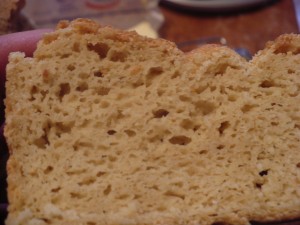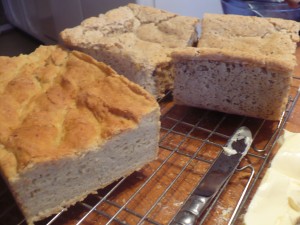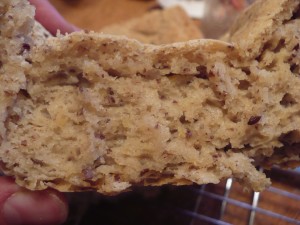

Loaf #5 – Gluten Free, Corn Free, Soy Free
Perfecting gluten free baking ofter requires several trials. The first two pictures are trial #3 of my new gluten free, soy free, corn free sandwich bread recipe. I think that it’s probably 2 or 3 more trials away from being ready to share with you. So far, the flavor and texture of the bread are great. I’d like to get a bit more rise on it though.
In this loaf I tried a few new techniques that are supposed to help the dough rise. The first is autolysis, a process in which you mix the flour and water and let it sit for 30 minutes before you add the remainder of the ingredients. I also added steam to my oven before baking and baked the loaf on top of a baking stone to provide more contant heat. Disappointingly, I didn’t notice a big change from earlier versions.
Trial #2 of this bread was made into gluten free hoagie rolls and they turned out really well.
Next up for this bread is a turn through the bread machine, which I haven’t tried yet. My bread machine loaves usually rise higher than my conventional oven loaves. Is there some magic to the bread machine? No. The bread machine pan is just not as long as my oven loaf pan, and the sides go up higher. As a result, the dough is forced up as it rises and you get a taller loaf.
I’m also going to experiment with different rising times. Perhaps this bread needs to rise for 2 or 3 hours, rather than the 1 hour that I’ve been doing. We’ll see =)


Loaf #6: Gluten Free, Corn Free, Soy Free, Egg Free
Now, these last two pictures are trial 2 of the egg free version. I’m using ground flaxseed to replace the eggs in this recipe. So far this bread has great flavor, but the insides are gummy. I made one change to the recipe for this 2nd trial and the bread is less gummy, so I’ll completely eliminate the suspected culprit the next time that I make this bread.
As you can see, this loaf completely caved in. It rose beautifully to the top of the pan, and then crashed when I put it into the oven. I guessed that this would happen when I was mixing the dough because the dough was wetter than the doughs that have turned out well in the past. When the dough is too wet it rises too fast and doesn’t have the structure that it needs to stay high when it’s put into the oven. The next version of this recipe will definitely have less liquids!
Hopefully, I’ll get around to loaves #7 and #8 today. The kids are headed to my parents for a few days for Spring Break and I want to send some bread with them.